
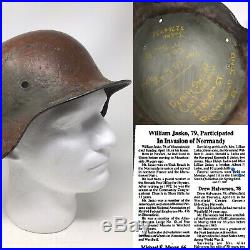
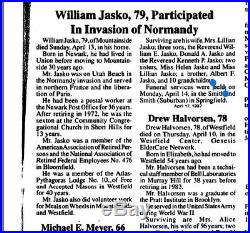
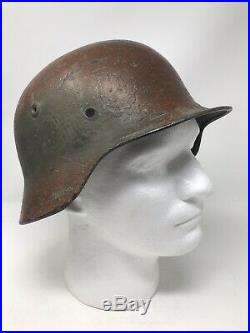
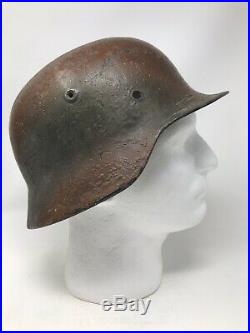
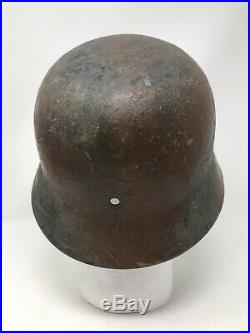
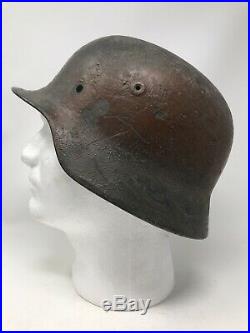
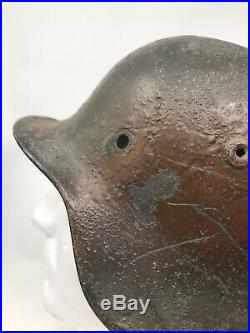
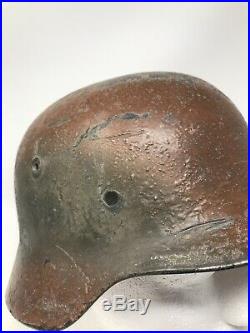
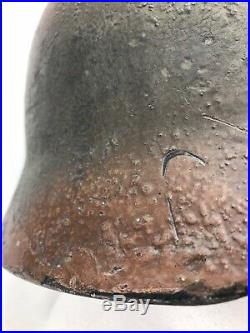
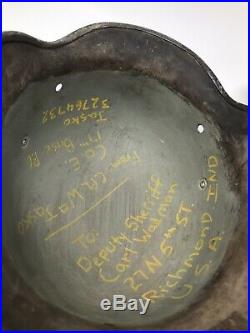
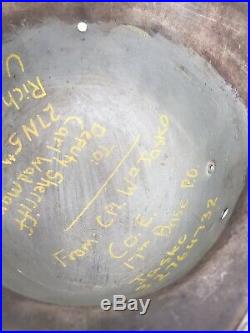
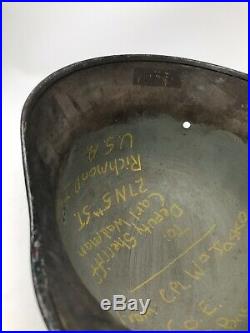

Jasko Utah Beach Normandy Captured 709th Infantry German Helmet Relic. William Jasko of Mountainside New Jersey served his country during WWII in the 4th Infantry Division and was a member of one of the first US infantry units to attack the German on Utah Beach during the D-Day invasion. Jasko later went on to serve in operations throughout Northern France as well as the liberation of Paris against the Nazis. This Normandy Camo German 709th Infantry Division helmet was captured by CLP. Jasko on Utah Beach and sent to a family friend Deputy Sherif Carl Wadman of Richmond Indiana following the landings on June 6, 1944. Before sending the helmet to family friend, Sherif Carl Wadman, CLP. Jasko took out the inside helmet liner and painted it with a grey/blue tone paint in order to address the inside clearly. In the listing you will also find the obituary given to me with the helmet of Jasko as well as records I have looked up regarding his family heritage and history. I want this helmet to go to a good home and someone who will value the history as I do. 4th Infantry Division Attach on Utah Beach. There are two sectors on Utah: Uncle Red and Tare Green, located between the towns of Dunes-de-Varreville (North) and La Madeleine (South). These beaches are defended by the 709th german infantry division which has installed seven strongpoints. Two coastal artillery batteries, located at Montebourg and Saint-Marcouf, can open fire on this beach, since these guns have a firing range of almost 30 kilometers. Army of Major General J. Lawton Collins will be engaged first. It is composed of the 8th, 22nd and 12nd infantry regiments of the 4th american infantry division led by Major General Raymond O. These units will launch the attack of Utah Beach on D-Day in order to capture the landing beach sectors, then to establish a solid beachhead and to carry out the junction with the airborne troops of the 82nd and 101st American airborne divisions. The assault must take place early in the morning at 6.30, a timetable that corresponds to the lowest tide. The Allies voluntarily choose this moment because the defenses of beaches installed by the Germans are clearly visible at low tide. Thus, the engineers can clear breaches on the beach in order to disembark the reinforcements. Tuesday June 6, at 3 oclock in the morning, the U fleet (Utah) arrives near the Cotentin beaches and damps at approximately 18 kilometers off the coast, a distance which limits the effectiveness of the German coastal batteries. The sunrise comes at 05:58 a. Exactly, 28 minutes after the beginning of the bombardment of the German positions by the allied warships. This huge bombardment follows air raids carried out by thousand of allied bombers. American soldiers of the 1st and 2nd Battalions (8th Infantry Regiment, 4th Infantry Division) who have embarked into the landing crafts are witnessing these bombardments which plow the French soil and fill the sky with immense plumes of smoke. Even though many of them suffer from a terrible seasickness, they are relieved to see their objectives under such a rain of steel. Two squadrons of amphibious duplex drive tanks are launched three kilometers from the shore and have to reach the beach areas by their own means thanks to two propellers and a rubber skirt. They progress in two waves of assault: the first one is composed of twelve duplex drive tanks and the second one is composed of sixteen identical tanks. But the amphibious tanks are falling behind and are soon overtaken by the landing craft of the 2nd Battalion which take the lead of the offensive on the beach area nicknamed Uncle Red. The 2nd Battalion lands on Uncle Red sector south-east of Saint-Martin-de-Varreville. The 1st Battalion lands fifteen minutes later on Tare Green beach area, east of Saint-Martin-de-Varreville, simultaneously with the amphibious tanks belonging to the 70th Tank Battalion (squadrons A and B). The latter reach the beach and immediately engage the opposing positions. During the first minutes of the 4th Infantry Divisions landing on Utah Beach, the German shots are numerous but not very precise. Gradually, German machine guns leave room for random but deadly explosions of shells fired by field guns belonging to the German 709. One effective, although more permanent method of concealing the helmet was the use of camouflage paint. It is up to some debate exactly when this method began among German soldiers but by the time of the Normandy campaign it was widespread. In mid 1943 the German high command ordered that a three color camouflaged scheme of tan, green and brown be used in the painting of vehicles and other equipment. These same paints were used to camouflage helmets as well. While the high command did order specific color codes be used for consistency, the hues of tan, green, and brown can vary on original examples significantly. The mix of these tan, green, and brown colors were used by German troops at Normandy with such frequency that today collectors call almost any German helmet with a mix of these three colors Normandy Camo. It should be clear that while the use of these three colors for camouflaging helmets was common, there was never a directive from the German military high command to paint helmets in this manor. No officially sanctioned Normandy camo existed. The collector term, Normandy camo can still be justified to a large degree. Photos from the battle as well as surviving original example with Normandy providence would indicate this particular camo pattern was a favorite of Germans during the campaign. The mix of the three colors was certainly a good choice for Normandy as the countryside does exhibit those same colors. That being said with much of Western Europes terrain looking so similar this same pattern would see action in other battles as well. The camouflage paints used at Normandy do not confine themselves to distinct hues of tan, brown and green. Some helmets were painted with two colors or just one and sometimes with non-standard military paints that were probably locally sourced. Further complicating the matter, captured British, Soviet, French and Italian paints were all used to camouflage helmets at Normandy. The hue of these colors often deviate from the standard German military colors. The German soldiers who camouflaged their helmets were well aware of their surroundings and certainly were aware of what colors and patterns would blend into the terrain they would soon be fighting in. It is logical they would have chosen colored paint based the local area which would account for the variation. Camouflaged paint was applied to helmets using a number of methods. The paint was issued from military stores in tins of concentrated paste which was produced in a manor to be thinned with either water or gasoline. The paint could be either sprayed or brush on. Usually this was only done to the outside of the helmet; however, sometimes the inside of the skirt was painted as well. In some very rare cases, the liner was removed so the inside of the dome could be painted as well. German troops attached to armored, artillery, troop carriers or anti-tank units had access to pneumatic paint guns. It is therefore logical that the majority of these men would have used leftover vehicle paint which they could apply to their helmets with the units pneumatic paint guns. Soldiers that did camouflage their helmet with paint guns often sprayed the paint with disruptive patterns that further broke up the outline of the helmet. Sometimes the paint was sprayed over netting to create a pattern when the net was removed. When mechanical painting equipment wasnt available, the helmet was painted with a brush. A rag could also be used to smear paint onto the helmets surface. During the painting process, the helmets decal was often carefully masked off and painted around, but it has been discovered that some decals were simply painted over. While the helmet factories had been ordered to cease applying decals in the summer of 1943, there was never an order given to men in the field to remove their decals. Therefore, any attempt at painting over the decal may be reasoned as indifference by the painter or perhaps as a true method of further camouflage, but not as an order from the high command. Because the painted surface of a helmet can take on a reflective sheen, German troops found ways to cut down on the glare. During the painting process, the wet paint was often sprinkled with sawdust, pebbles, grit, wood chips, seed casings, and even bits of dry grass. This created a rough finish which cut down on the reflection. The item “WWII 4th Infantry CPL. Jasko Utah Beach D-Day Captured 709th German Helmet Relic” is in sale since Tuesday, May 7, 2019. This item is in the category “Collectibles\Militaria\WW II (1939-45)\Original Period Items\Germany\Hats & Helmets”. The seller is “curio_artifacts” and is located in Algonquin, Illinois. This item can be shipped to United States.
